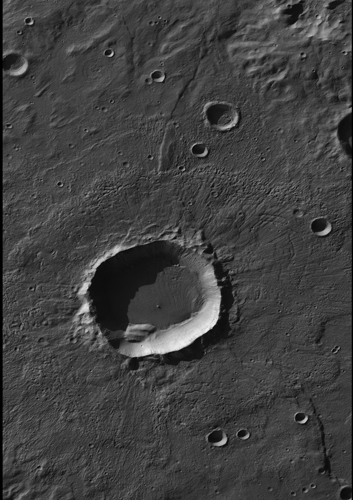

CTX-9: Crater in Terra Sirenum with Gullied Walls 24 meter/pixel version (1.5 MBytes) 12 meter/pixel version (5.4 MBytes) 6 meter/pixel version (full resolution)(20.6 MBytes) Image credit: NASA/JPL/Malin Space Science Systems |
|
The largest number of gullies on Mars occur on the walls of southern hemisphere craters. During southern winter, many of the gullied walls are in shadow. It has been known for many years from Mars Global Surveyor Mars Orbiter Camera images that frost forms on these shadowed slopes and that differences in the amount or nature of the frost deposits highlight the gully floors and deposits. Such differences may occur because the materials are of different particle sizes, or have other differing attributes that affect their thermophysical properties. To investigate this phenomenon, CTX acquired this image of a crater at 39.3°S, 136.5°W, where gullies were known to display frost during winter. To see the gullies, download the image and view it in an image processing program, as they are nearly invisible in the normal contrast image. The HiRISE team elected to "ride along" with the CTX observation, and their spectacular color view of the frosted gullies can be seen at http://mars.jpl.nasa.gov/mro/
|
Malin Space Science Systems built and operates the CTX and MARCI onboard MRO at its facilities in San Diego, California. The Jet Propulsion Laboratory operates the Mars Reconnaissance Orbiter spacecraft with its industrial partner, Lockheed Martin Astronautics, from facilities in Pasadena, California, and Denver, Colorado.